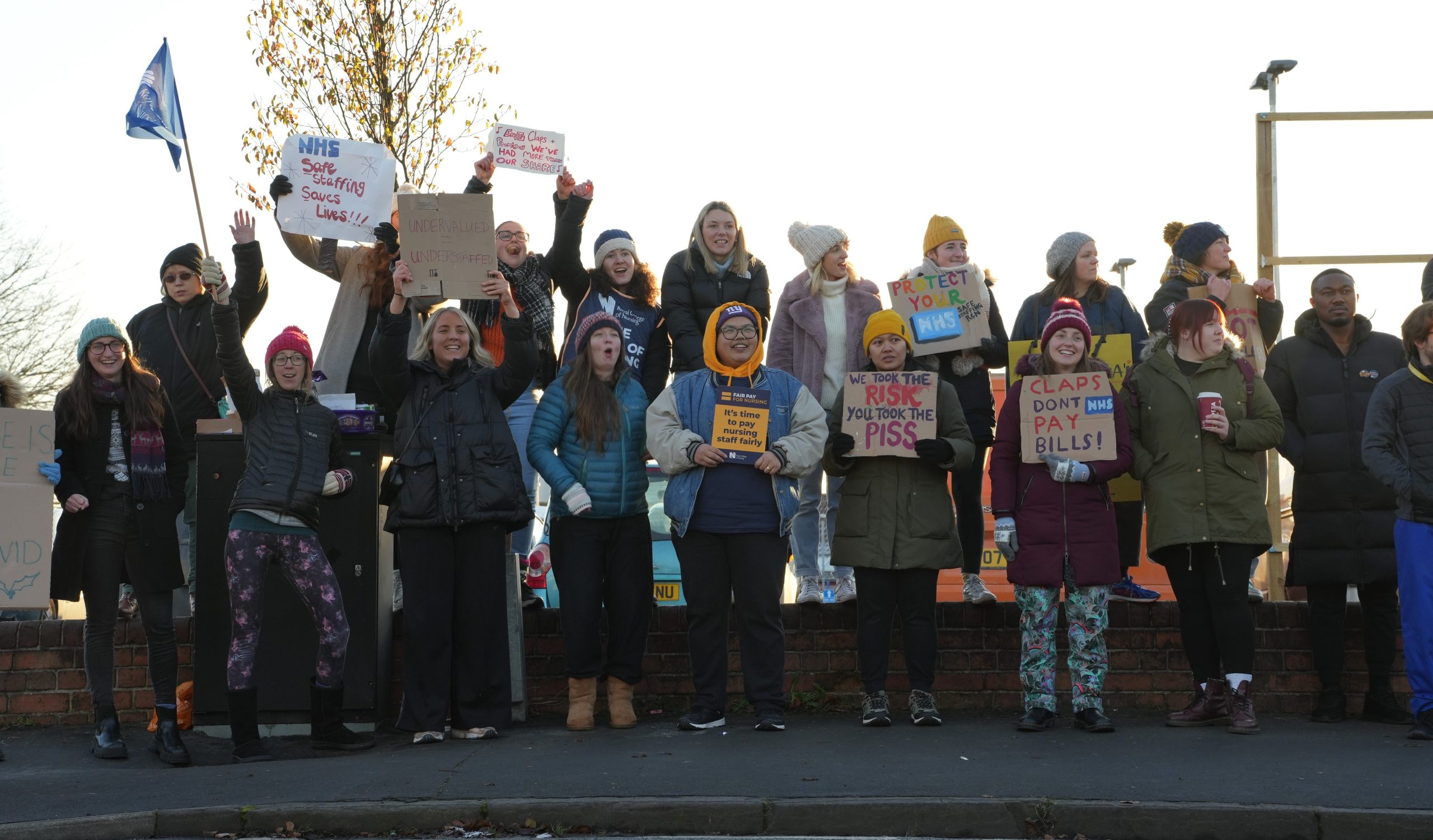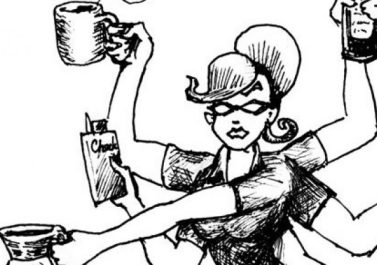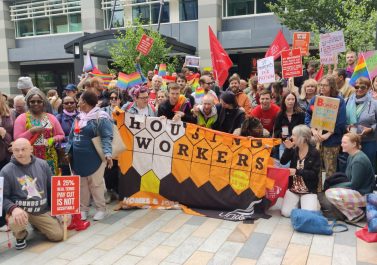
The fact that, after three decades, nurses have gone on strike again in the UK is positive, at the same time we need to have a careful look at the weak points of the strike in order to learn for the future. The following impressions and thoughts after two days of industrial dispute are preliminary and sketchy, limited to experiences in three bigger NHS trusts in the North of England, the Midlands and the South-West. You can find further ideas in our strike newsletter, but more importantly, please write to us and share your own thoughts from your hospital or picket line.
- The run up: Problems with the pay campaign and ballots
Despite the initial commitment to a joint pay demand by the various unions within the NHS, the union divisions became apparent early on, first of all when the RCN pulled out of the common platform and raised their separate pay claim back in April 2022. The lack of coordination between the unions was also reflected on the ground in hospitals, e.g. in a major hospital in the south-west, the Joint Union Committee, comprising six different unions, rejected the proposal from a Unison and GMB rep to hold a joint pay rally in front of the hospital. Instead of a visible and collective preparation for the industrial actions, the individual unions limited themselves to emailing, texting, phone banking and other individual outreach to members, plus the very occasional stall in the canteen area. These forms of ‘virtual campaigning’ with a lack of people actually coming together in bigger groups, had already failed during the previous pay campaign, when the unions were still able to blame Covid for their own timidness.
It was, therefore, not surprising that during the current pay dispute in England, apart from the RCN, none of the other unions (first and foremost Unsion, the biggest union in the NHS) came close to meeting the legal threshold of 50% membership participation in the industrial ballot. Less than 40% of the members of Unison bothered to take part in the ballot, though over 80% of members who participated did vote in favour of industrial action.
The fact that the RCN met this threshold might be because of three reasons:
a) at least in the Midlands, friends reported that there were some ‘ward walks’ of RCN activists in the run-up to the ballot, which might have created more of a mobilisation;
b) their ‘marketing strategy’ was the most visible, timely, and targeted towards strike action. They had planned their promotional materials in advance, and they were focused on answering specific questions around the possibility of nurses taking industrial action;
c) the ‘professional nature’ of the RCN, the focus on registered nurses and their professional development created more direct links and a certain cohesion. This apparent strength of the nurses is the weakness of the NHS strike, as other groups of health workers, such as housekeepers, porters, cleaners, health care assistants remained largely absent from the dispute.
The divisions amongst the unions and the top-down nature of decision-making about the strategy of the industrial dispute then became more apparent in Scotland, where unions balloted separately from England and where most unions met the legal threshold for industrial action. Partly because of the wider participation in the industrial ballot, the government in Scotland had increased the pay hike from £1,400, like in England, to £2,200 per year. Despite the new offer still not meeting the pay demand of the unions, the union leaderships across the board decided to re-ballot the membership who rejected the new offer. Despite this rejection, the Unison leadership decided to re-open negotiations with the government, proposing a lower pay increase for Band 5 (general nurses) and above. The Unison leadership recommended accepting it and when 57% of the voting members did so, Unison called on the government in Scotland to implement the pay increase as soon as possible, despite the fact that the RCN continued to ballot their members for a higher increase. The Unison leadership thereby undermined the industrial action of a significant chunk of the workforce in Scotland, signaled good will to the government, and significantly lowered the expectations for the ongoing campaign in England.
- The strike preparation from the government, trust management and the unions
In the hospital in the south-west, management and union reps of the joint union committee met initially in talks that treated the upcoming industrial action as a ‘serious incident’, similar to grave accidents, and started discussing possible derogations and exemptions. In contrast, there was no collective meeting of all unions on how to support the RCN strike and no communication towards the members and workers. The only emails that were sent by Unison and GMB to their own members made clear that, as both unions failed to meet the legal threshold, members could not participate in the RCN strike. Trust management sent emails that they respect the right to strike, but at the same time increased payments for bank workers between mid-December and mid-January by 30% for nurses and 15% for the rest, incentivising people to take on extra shifts. At another trust in the south-west, management offered 50% extra pay for shifts on the strike day of the 20th of December.
In the meantime, the government, at least initially during the week before the first strike day, added some stick to these carrots. On the 7th of December, they first threatened to legally ban strikes in the health sector, but that threat was not repeated until a month later. On the 10th of December they then spoke publicly about using army personnel to replace striking workers. This turned out to be a paper-tiger early on, as the number of potential soldiers was very low (around 600 army drivers and 150 logistical staff compared to a total of 16,000 plus ambulance paramedics who were balloted to strike) as they often lacked the necessary qualifications and knowledge. There were also voices amongst the military that criticised the government’s announcement as it threatened to ‘undermine the morale amongst the troops’, if they felt that they would be used as pawns in industrial actions.
In England the RCN leadership decided to limit the first round of strikes to 44 trusts out of the 102 that met the legal threshold for strike action (out of 215 eligible in England). There might have been an ‘escalation tactic’ behind the decision to call out only a smaller number of workers, but it caused frustration amongst those members that had voted in favour of industrial action.
In tandem with this, the main way to limit the impact of the strike action was the co-management between the RCN and the NHS hierarchy of the so-called ‘derogation’, the exemption of certain departments from the strike and/or the imposition of minimum staffing levels on certain wards.
- The issue of strike exemption and derogation
The question of which departments would be subjected to derogation was handled by the top-level of the RCN, together with the medical authorities. Some of the decisions, e.g. to add mental health and community services to the derogated areas caused minor discontent amongst rank-and-file members, but was never openly contested. After the general field of the strike was staked out from above, local RCN reps and committees then decided about minimum staffing levels during the strike. Before we look at how this was done in concrete we should state that this issue is at the heart of the question of who is in control of the strike. Workers on each ward know best what their current patients need in terms of minimum health and safety and would be able to coordinate how many workers can participate in the strike. This act in itself would have boosted a sense of collective control and power. Instead, the way that derogation was negotiated between a few RCN reps and management left a lot of scope for confusion, sometimes deliberately caused by arbitrary management communication, about ‘the right to strike’, and most workers felt pretty manipulated by or disengaged from the process.
In the trust in the south-west, a very small number of reps negotiated the derogation for all medical wards, stipulating that during the strike days there should be a minimum of four registered nurses and five healthcare assistants. The irony is that even on the best days there are hardly ever five healthcare assistants on the wards, more often than not there are three. The union justified these minimum staffing levels that objectively limited the amount of possible strikers with the following argument: ‘as a union we campaign generally for better staffing levels, so how can we, when asked, agree to low minimum levels during strike days?’
Many nurses and RCN members were pretty upset about these minimum staffing levels, as they allowed management to declare that no one who is scheduled to work could go on strike – even though this wasn’t actually true. There were many individual texts and emails from ward managers to people who they suspected would go on strike – allegedly in order to be able to ‘plan for the strike days’. In some wards, managers ‘allowed’ workers to go on strike, often for a limited amount of hours. If your ward sister was more supportive of the strike, it was easier to agree your participation.
Even if this was not intended by the RCN, the way that the derogation process was handled left the management of the strike largely in the hands of the trust hierarchy. We heard of a few cases where nurses decided collectively on a ward level how many and how long to attend the strike picket – more about that below. There was also an individual case where management and nurses complained about ‘intimidation’ by RCN reps who walked around the wards and checked how many people were working and how many were on strike – in general the number of RCN reps and activists were too low to actually ‘sweep’ the wards.
Things were similar in the hospital up north. “In our Trust the list of derogated areas grew longer by the day, with what seemed like the whole hospital derogated from strike action. The Trust also encouraged staff to think that striking in derogated areas wasn’t allowed, but this felt like it backfired, and a number of staff who weren’t going to strike did so as they felt like the Trust was trying to minimise the impact, and thought they’d been slightly deceptive in trying to do this.”
In the hospital in the Midlands, the picture varied a bit. A comrade reported the following about the derogation process:
“In our trust there was a quite large derogation committee, made up of non-rep members from across a wide range of areas. Most of these members had not been involved in the RCN before the ballot, they only got involved in ward walks and in spreading the word about the ballot during this pay campaign. However, despite the large committee recruited from the membership I think everyone was at least a band 6. The general attitude (including from the RCN officials involved) was one of wanting to go relatively hard on saying no to the derogation, but there was a lack of confidence at times, and second guessing. The trust sent in very few requests for derogations in the first week when the strike committee was meeting and then bombarded it with an unmanageable amount in the last few days. This might have been a deliberate attempt by management to sabotage the committee or confusion on their part about the actual numbers of strikers, or both. In the end, the trust asked for a blanket derogation of the wards, to which the reply was: ‘Well, we already said you could have night-shift staffing numbers on strike days, that’s enough. If you don’t have these numbers on the day, come to us’ (with some back and forth in the committee on how strongly to put this)…
In the end, this only created more confusion, in part because of the difference between the on- paper night numbers and the real ones. On the day there was an attempt to encourage staff to leave if it was over the normal night number, but this had mixed results. One member of the strike committee ended up being accused of bullying by senior management while doing this, this was at a different site to mine within the same trust. We also know that on several wards they lied about the amount of staff on the ward and had prepared staff to repeat these lies when asked. I know that at least some members of staff left the wards after seeing the numbers were higher than needed and one derogated team decided that their derogation was too generous on the first day and independently chose to decrease their numbers on the second day. There was also continuous fight over the derogation of one postoperative area, which the trust claimed was a High Dependency Unit (covered by national derogation), but which the staff that were working there stated was not. In the end, the professional body side of the RCN got involved, stating, “we helped develop the model of care this ward uses and wrote the definition, it’s not a HDU”.
- The actual impact of the strike
It’s difficult to assess the actual impact of the strike on a national level. The Guardian quoted a NHS senior manager after the first day of strike who claimed:
“I think we do know that there were some real pressure points around emergency departments, for example, including things like the slow transfer of patients out of those departments.In terms of things like routine operations, so far we’ve heard that probably between around 40 to 60% of those routine operations have been cancelled in places where the strikes were held.”
On a hospital level, the impact of the strike differed sharply from ward to ward. In the hospital in the south-west, some workers reported that they actually had higher staffing levels on the strike day than normally, in particular in the emergency department. On other wards, colleagues said that matrons and managers had to do bed care and bring patients to the toilet – which can clearly be stated as a positive result of the industrial action in terms of educational value (“it’s good if they get their hands dirty every now and then”). On a more subjective note, it seemed that there were more relatives of patients around, perhaps in reaction to the strike, anticipating that a few extra hands were needed for personal care – but that might also have been due to Christmas approaching.
From the Midlands we received news regarding the use of military personnel: “My trust has a large amount of military staff working in it. In one case a decision was made not to derogate any members of staff on a ward (even down to the reduced night-shift numbers) based on the knowledge that it would have enough military nurses to staff it that day. The military nurses, however, refused to work until someone came up from the picket line to take the handover. In the end one person agreed to go up until 11 am. Apart from this, several elective services were stopped and some wards truly were at minimal staffing numbers, but others were actually above the standard numbers due to the confusion created by the process and the difference between the real standard numbers and the official night numbers.”
- On the picket lines
The level of participation in the picket lines can be seen as another indicator for the mood amongst those on strike.
In one south-west hospital, the RCN reps were first of all concerned with the legal nature of the picket. In the run-up, various leading reps of the joint union committee said that, for example, there should be no loudspeakers and music on the picket, as ‘we would lose support from the public’. This hospital’s actual picket was placed 300 meters away from the main entrance of the hospital. The picket itself was pretty lively, with around 80 people participating at each given point, with a relatively high turnover, also due to the weather – out of a total of 10,000 people who are employed at the hospital. The lively mood was also partly due to the fact that official guidance was ignored and music was playing. It was good to see that many nurses came in ward groups, but then they often also seemed to stay in their groups. From my ward, only four nurses came, though it was good to see that it was recently hired nurses from the Philippines. Also good to see that there were many self-made placards, perhaps even more than official union ones. There were mainly young nurses in their 20s, early 30s, unfortunately only a handful of HCAs, no porters or cleaners or housekeepers. It was good to see groups of student nurses. There were no speeches, which is good, in the sense that we did not have to listen to any ‘official talks’, but bad in the sense that there was nothing that would create collective discussion. Pat Cullen, the RCN leader, did pop by on a whistlestop picket tour, too. People mainly seemed to enjoy each other’s company and the shared discontent with the government, but there were not many discussions about how to strike. There were only three CWU reps and one RMT rep who came for a visit, but they didn’t address all strikers. The main discussion was that the derogation was arbitrary.
At another south-west hospital, around 100 nurses and supporters were directly outside the hospital and facing a main road. There was lots of public support. There were official picket stewards, but no real distanced separation between them and other strikers/supporters, which was nice to see.
In the Midlands in general there was a very positive attitude on the picket line, people were excited to be there. Despite the RCN ban on amplified sound and heavy emphasis on the official limits on picket size and having additional supporters separate, we ended up having speeches, music and a crowd of around 200 with no clear separation of the official picket. There was a high level of support for the picket from the public and non-nursing members of staff. We had so much food donated that we had to go round the ward to share it out for the night shift. On the first day there were issues of the senior management hanging out around the picket and the strike committee meeting room. They were trying to get people to come up by arguing that the wards were not at safe levels. This did not occur as much on the second day.
At the hospital in the north there were mostly nurses in attendance, with some domestics and others as well. Staffing levels and stress and being overworked were common themes as much as pay. It felt like it had glimmers of some confidence and a more general ‘fuck it’ attitude as well. We also read about a few ‘unofficial actions’ when it came to the picket lines from a WhatsApp group:
“I’m an RCN member and nurse working in Norfolk. Our picket line was set in Luton last week and it is as far away again on Tuesday. A fabulous like-minded group of amazing nurses started their own unofficial picket at the car park next to Havenbridge House (Great Yarmouth) last week and since then they’ve managed to get RCN to support and change the picket line from unofficial to official!!!!”
- Reaction of the government and the union since the strike
The initial threat by the government to ban the strike legally or to undermine it by use of the military remained empty, while the effort by parts of the media to portray nurses as ruthless and greedy people on middle-incomes also largely backfired. According to surveys the public support for the nurses is still high. Meanwhile, Labour continues their anti-strike stance, with the shadow health secretary vowing to fight ‘hostile NHS unions’ that oppose necessary restructuring.
The union itself used a relatively weak strategy by offering to ‘call off strikes in return for talks’ before the first strike days and by halving the pay demand from an above inflation increase to a below inflation increase (another real wage cut) ‘in return for talks’ before the second round of strikes in January. The RCN hopes that portraying the government as ‘unwilling to negotiate’ alone is enough to get results. This strategy might backfire in various ways. Firstly, by trying to ‘blame the government for the strike because they are unwilling to negotiate’ portrays the strike itself as a negative thing, which weakens workers once they decide to continue the industrial action in a more offensive manner. Secondly, by offering to lower the pay demand without consulting the members they further undermine the sentiment that members themselves are in the drivers’’ seat. You can only blow hot and cold so many times before people get fed up.
In the Midlands there has been a recognition of the need for greater intelligence gathering based on the response of frontline nurses on the real numbers on the ward as opposed to the official establishment numbers. This could provide an opening for an inquiry based grassroots engagement and taking the lead in the struggle from union officials.
Another problematic decision by the RCN was to exclude those hospitals who went on strike in December from the strikes in January. This caused confusion and a feeling of being ‘managed’ by the union. The comrade from the north wrote: “We have more RCN strike days coming in January, but the RCN has split the Trusts striking and ours isn’t, which has annoyed staff that I’ve talked to.”
The negotiation circus continued in January. After the RCN lowered their initial demand the government softened their first stance and offered talks and a possible ‘one off payment’ in the form of ‘hardship relief’. Already in December some Tory MPs had already urged the party leadership to negotiate. For the government it becomes a gamble of how to tame the rail, postal and NHS strikes that are happening at the same time. To ‘buy off’ the RCN might be a way to come down hard on the rail and postal strike. While the unions might schedule their strikes to coincide on the same day, we cannot expect the RMT, CWU and RCN to actively and explicitly join up their strikes, in terms of continuing their action until all of the respective unions’ demands are met.
- Proposals
We don’t have major proposals at this point in time, but the following activities might be fruitful:
- Discuss the first round of strikes and share your experiences – we are happy to circulate them;
- Discuss with colleagues, first and foremost with health workers who have not been part of the strike, such as porters, cleaners or HCAs, how we can strengthen the strike and make our voices heard;
- Go in bigger groups of health workers to actively support pickets of other strikers and make them as effective as possible;
- Discuss the positive and negative experience of your strike with workers on strike at the railways, at Royal Mail and other places;
- Try to find out more about how the ‘minimum service’ derogation was organised during the more successful health strikes, such as in Germany;
- Picket private clinics during strike days in order to cause more financial damage – of course considering patients’ health and safety.



